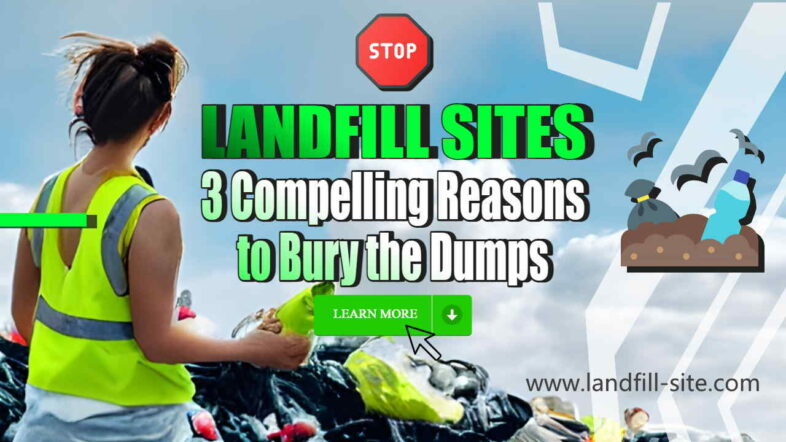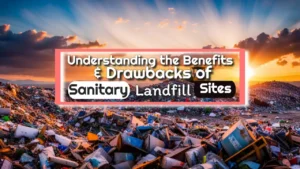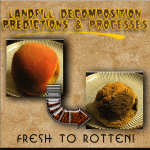Landfill Sites are not sustainable, and here are 3 compelling reasons to bury the idea that we continue to use landfills (dumps) for municipal waste beyond the next 10 years. All waste has to be disposed of in a safe manner. If not it is a major health problem in densely populated urban areas, second only to a lack of drinkable water, as it contributes to the spread of disease and negatively impacts the quality of life.
Read on and you will discover the 3 reasons why landfilling has to stop:
- It is a Future Time Bomb: Historically our dumped waste was self-composted, but that changed long ago. Now landfills just store our detritus to cause inevitable damage to harm future generations. It is time for the engineering community to accept that reality, and stop pretending stabilisation is possible in modern landfills.
- It is a Health Problem Today – Landfill Gas May Cause Respiratory Disease: Landfill gas around an active landfill operation has at the very least been shown not proven safe against health risks (in a recent UK legal case) to local residents. Reopening old concerns.
- It is Not Even Necessary: Huge reductions in the amount of municipal and commercial waste have already been achieved without evident damage to the economy. So, the alternative which is often known as the “circular economy” is proven to be feasible and should be given further encouragement by banning future landfills.
The Historical Background to “Dumping” and “Tipping” that Evolved into “Landfilling”
The landfill was the primary method of waste disposal in the United Kingdom for over 120 years. Until the 1970s, landfill sites were simply some large, and a myriad of small, holes or tips. This method of waste disposal was incredibly inefficient, expensive, and damaging to the environment.
Thankfully, the UK has since transitioned about half of its domestic and commercial waste to more sustainable and effective methods of waste disposal, such as incineration and recycling (see more later).
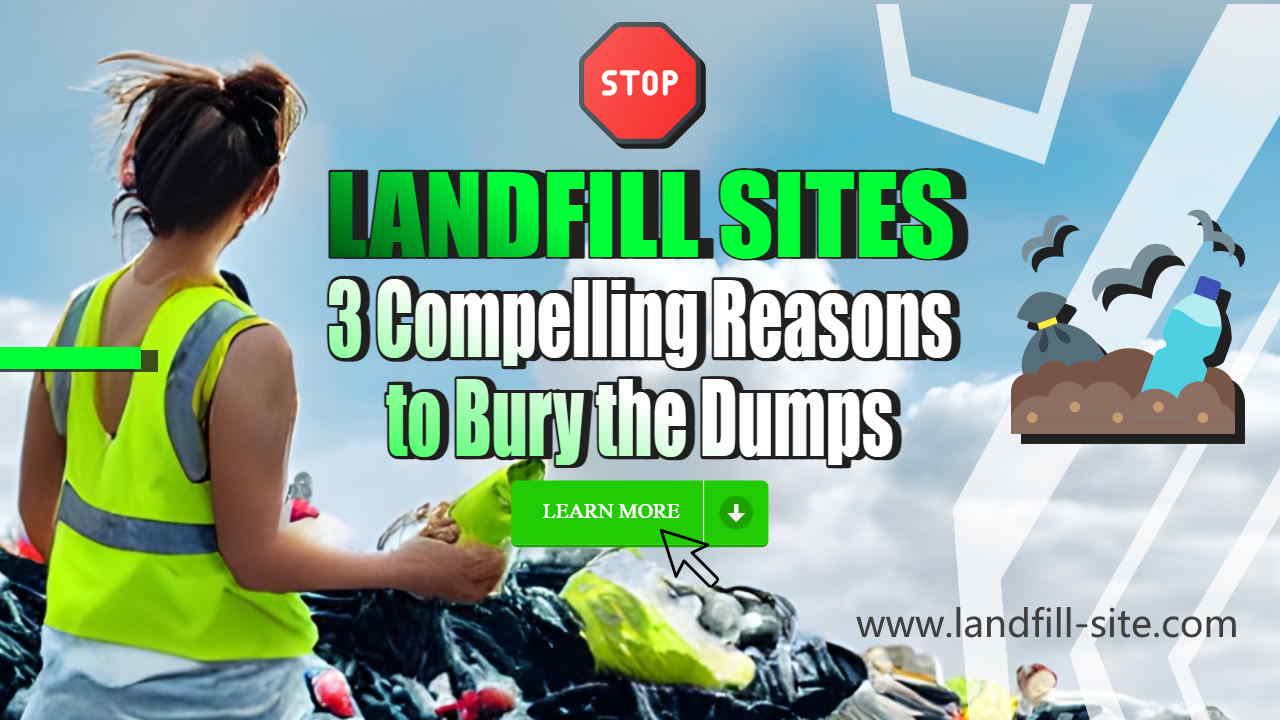
Modern Landfills are Not Just Large Holes in the Ground (Or Ground Raises)
But landfills are no longer just large holes in the ground. They are now complex engineered systems that are designed to minimize environmental impacts.
What Landfill Lining Systems Do
The landfill lining system is the most important component of the landfill. It is a multi-layered system that is designed to protect the environment from leachate (the liquid that comes out of the waste). The bottom layer of the landfill is made of a clay liner. The clay liner is used to prevent the leachate from escaping the landfill. The second layer is made of a geomembrane. The geomembrane is used to protect the clay liner from punctures. The third layer is made of a geosynthetic layer. The geosynthetic layer is a blanket provided to protect the geomembrane.
But this does not mean that the modern landfill is environmentally benign, even in the first 100 to 150 years when the landfill containment lining is likely to remain fairly intact.
Landfill Design Before the 1970s
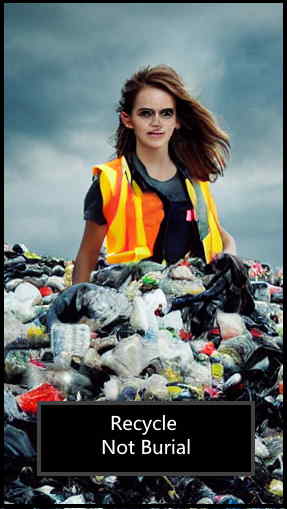 The principle behind landfill design before the 1970s was that pollutants from the dumped waste will be diluted and dispersed over time until they become harmless. This assumes that pollutants are generated slowly and will spread out into the surrounding environment through chemical, physical, and biological processes.
The principle behind landfill design before the 1970s was that pollutants from the dumped waste will be diluted and dispersed over time until they become harmless. This assumes that pollutants are generated slowly and will spread out into the surrounding environment through chemical, physical, and biological processes.
This may have worked previously in rural communities where input rates were low, and most of the rubbish was ash from wood and coal burning. Before the introduction of gas central heating, most wood and paper were burnt on home fires, resulting in a largely inert ash content with added vegetable matter. This combination tended to self-compost with only a short-term impact on the local environment.
The 1970s Advent of Central Heating and Single-Use Plastics
But, as most homes transitioned to natural gas-heated boilers, and plastic became the predominant form of packaging, all municipal waste changed for the worse. Waste engineers reacted by making landfills much larger and basing them on the “containment” principle instead of the previous largely discredited “dilute and disperse” philosophy
The old approach to landfill pre-1970 was ineffective and henceforward caused significant pollution of the air, water, and soil.
Additionally, it had negative social consequences. The current designs known as sanitary landfills are now recognised as being no better than “dilute and disperse” for the local residents, and for storing up problems for future generations.
Surely Modern Landfill Design Stabilises the Waste/Makes it Safe?
No. Not really.
In order to meet today's regulatory and research requirements, the intention has been that landfill sites must be designed to contain waste in a way that stabilizes it physically, chemically, and biologically.
That sounds great, doesn't it? So, how could there be a problem?
However, those mighty words were overridden in Europe when the EU absolved all landfill design engineers from the responsibility for complying with that high ideal (by enacting the EU Landfill Directives in the 1990s).
The EU legislators ignored the reality and prescribed containment in terms of the thickness and type of landfill containment engineering. From that moment on no landfill engineer/designer could innovate to produce a self-stabilising landfill, even if that was technically possible.
The issue of stabilisation was simply ignored in the EU legislation. The EU regulations stated what had to be done to construct a landfill in order to obtain a permit to operate it, and most of the rest of the world simply blindly followed the EU's dictate.
Now the problem gets more serious every year that passes.
The Problem with Attaining “Landfill Completion”
A stabilization process does not really exist in any compliant “Sanitary Landfill”. Stabilisation is a fudge created by EU politicians and the problem of the lack of it is known as the problem in attaining “completion” status for any completed and filled landfill.
Landfill completion is important for the landfill owner and all those who live near a landfill. Once completion is achieved, the contents of the landfill must be in a condition unlikely to pose a pollution risk and when it is the owner can apply for and be granted a completion certificate by the regulatory body (Environment Agency England etc.).
In the UK, there are strict regulations in place to ensure that landfill operators cannot simply abandon their sites and walk away from future problems. They must demonstrate that the site no longer poses a threat to human health or the environment before they are allowed to walk away from it.
The problem is that experience is showing that attaining stabilisation and proving “completion” to the regulatory bodies is in reality not possible. The result is that old landfills must be financed into the future in order to carry out environmental repair work on them whenever it is needed.
But who and how would this open-ended commitment ever be funded?
This is obviously unsustainable and therefore it is accepted that landfilling of all but some clean inert materials will have to stop.
2. It is a Health Problem Today – Landfill Gas May Cause Respiratory Disease
In September 2021, the High Court made a landmark judgement ordering England’s Environment Agency to take stronger measures to protect the public from landfill gas. The court ruled that Walleys Quarry landfill site was exacerbating 5-year old Matthew Richard's respiratory health problems. This judgement will have important implications for environmental law and policy moving forward.
But it is a fact that the Environment Agency has been concerned about landfill gas for more than 20 years. In response, at that time the agency funded the development of GasSim, a landfill gas risk assessment model.
There is currently conflicting research on the health effects of landfill gas on local residents. Some believe that there are health risks associated with exposure to the gas, while others believe that more research is needed before any conclusions can be drawn.
3. Landfill is Not Even Needed!
In 1999, the European Union's Landfill Directive established goals for reducing the amount of waste that is sent to landfill. The UK, and the rest of Europe, have committed to reducing the amount of waste it sends to landfills. Instead, the European nations are focusing on incineration, composting, anaerobic digestion, recycling and reuse in order to recover/reclaim some value from waste.
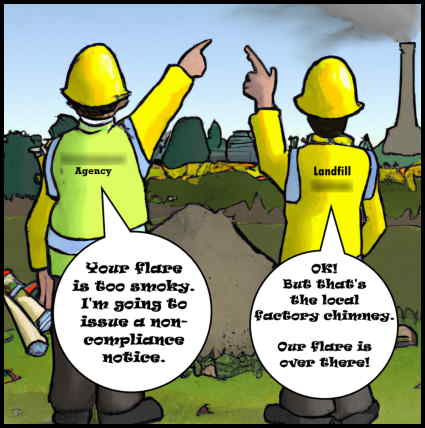 As a result of this, the number of landfill sites in the UK has decreased significantly, from around 23,500 in 2001 to just 574 in 2021. This is a massive improvement echoed by many other European nations and something we should all be proud of. Total waste disposed to UK landfill sites has decreased significantly, from over 90% in 1996 to around 24% in 2018. This is a major positive development.
As a result of this, the number of landfill sites in the UK has decreased significantly, from around 23,500 in 2001 to just 574 in 2021. This is a massive improvement echoed by many other European nations and something we should all be proud of. Total waste disposed to UK landfill sites has decreased significantly, from over 90% in 1996 to around 24% in 2018. This is a major positive development.
Despite advances in recycling and waste management, landfill remains a significant environmental problem. Landfilling is expensive and difficult to manage, and even in the short term, it can have harmful consequences for the environment. Never forget the potentially major risks that even modern landfills can pose to the environment and public health.
A recent review concludes that while disposing of solid waste in landfills is still risky, it is unlikely that developed countries will be able to move away from landfill entirely within one generation.
I don't agree with that. It lacks the ambition to achieve achievable aims.
Waste management is a pressing global issue, and I believe that we should be taking a proactive approach to sustainability. The waste hierarchy is a key tool in this effort, as it provides a framework for guiding decision-making in waste management.
By “aiming high” in terms of the hierarchy, we can make significant progress towards sustainable waste management.
Has the UK Gone Backwards Since 2019?
It's, unfortunately, true that the amount of waste disposed of in landfills in England increased by 4% in 2019, as reported by the Guardian Newspaper.
Although only 8% of local authority-collected waste was landfilled in 2019/20, 30% of food waste and 59% of textile waste are currently landfilled across all sectors. If we are proactive and determined to turn words into deeds, there is clearly a lot of room for improvement.
Conclusion to “Compelling Reasons to Bury the Use of Dumps/ Landfill Sites”
We have begun to take collective responsibility for the resource use on which our standard of living is based, as well as the ecosystems that are essential to life.
As part of that reality landfills must be seen for what they are:
- A future time bomb
- A current health risk, and
- Not even necessary!
In addition, we are being compelled to act by the realisation that:
- resource availability is dwindling,
- waste-related climate impacts are real, and
- physical space for traditional waste management practices is becoming scarce.
Instead of burying or burning waste, waste prevention, reuse, recycling, and the circular economy must be prioritised.
Ban all new landfills now to ensure that the waste burden is reduced, the economy is developed sustainably, and today's products can be designed to form tomorrow's raw materials.
The time has come to permanently bury landfill for the sake of public health and the environment.
Understanding the Benefits and Drawbacks of Sanitary Landfill Sites
In this article, you will find out about the advantages and disadvantages of sanitary landfills. Deciding on the best way to handle rubbish, is a common challenge, especially in developing nations. Sanitary landfills offer one solution, but they come with pros and cons. This article will help you understand these landfill sites better, including their benefits and drawbacks. Stay […]
Waste Decomposition and Degradation of Waste in Landfills
Waste Decomposition: The Main Stages of waste decomposition, otherwise known as the waste degradation process An understanding of the Main Stages of waste decomposition. Which is alternatively called “the waste degradation process” is essential to understand how a landfill will gradually change over many years. We are often asked how many years will it take […]
What are the Confined Spaces Regulations 1997
Confined Spaces Definitions (United Kingdom H&S Regulations) There are two commonly used definitions:- The Confined Spaces Regulations 1997 (2) In these Regulations, unless the context otherwise requires – “confined space” means any place, including any chamber, tank, vat, silo, pit, trench, pipe, sewer, flue, well or other similar space in which, by virtue of its […]
Aerobic Landfill and Why The Subject Will Not Be Forgotten
A key topic raised in many countries, not least Japan, is why most other industrialized nations have gone so strongly for sanitary landfill design, which locks up waste and only slowly allows it to decompose with air (anaerobically) and not aerobic landfills which rot away quickly. The awful longevity of sanitary landfilling, becomes clear when […]
